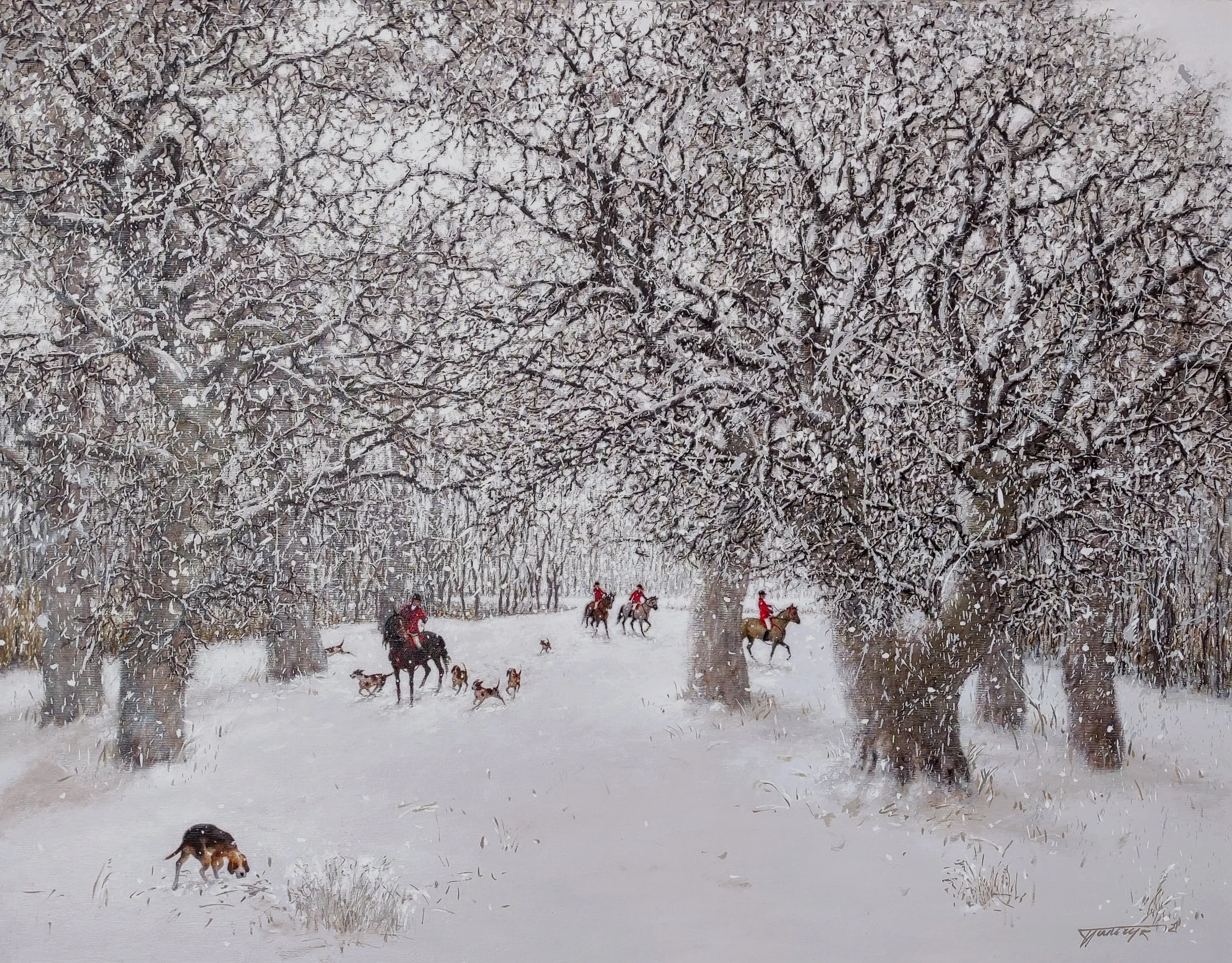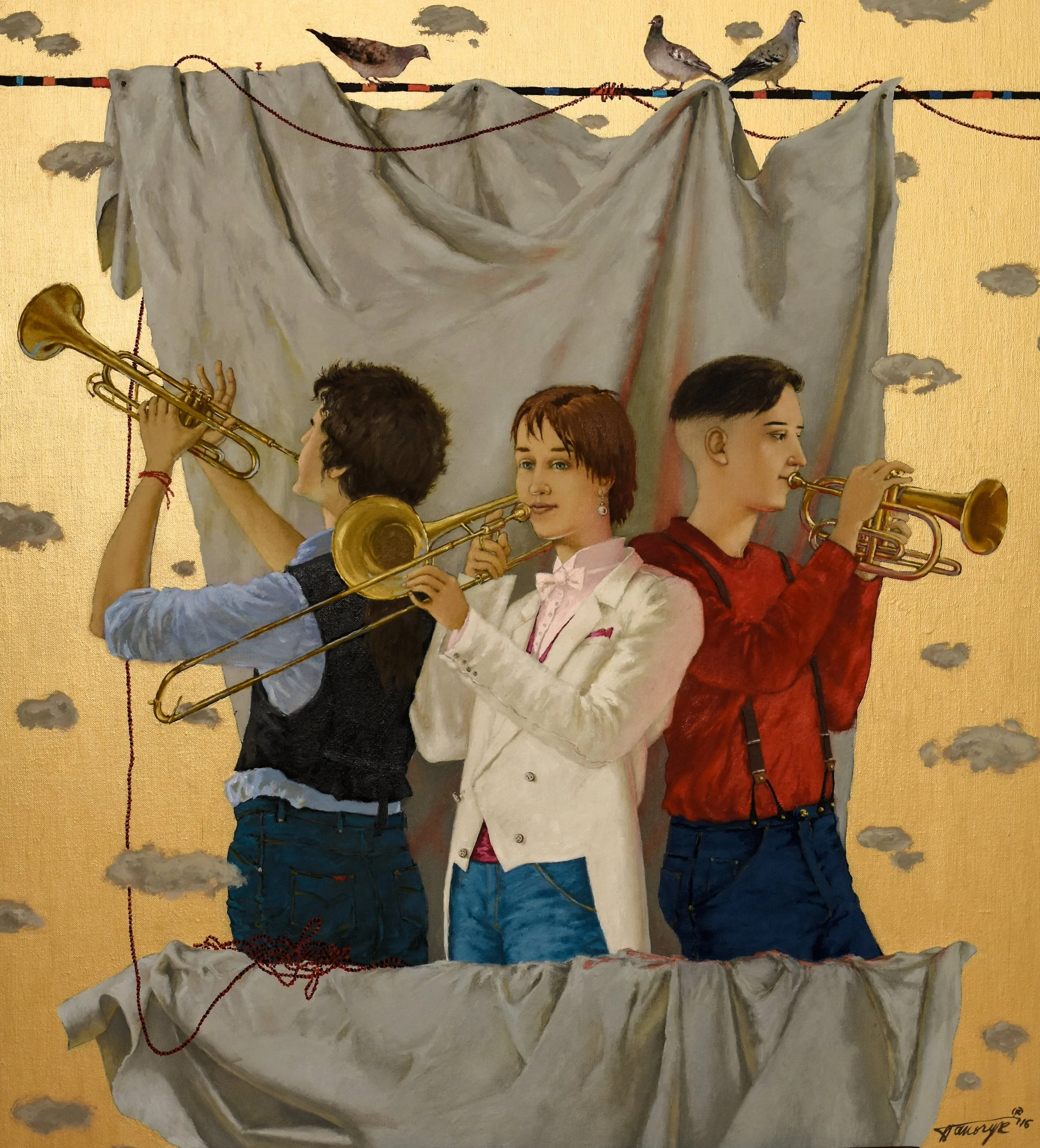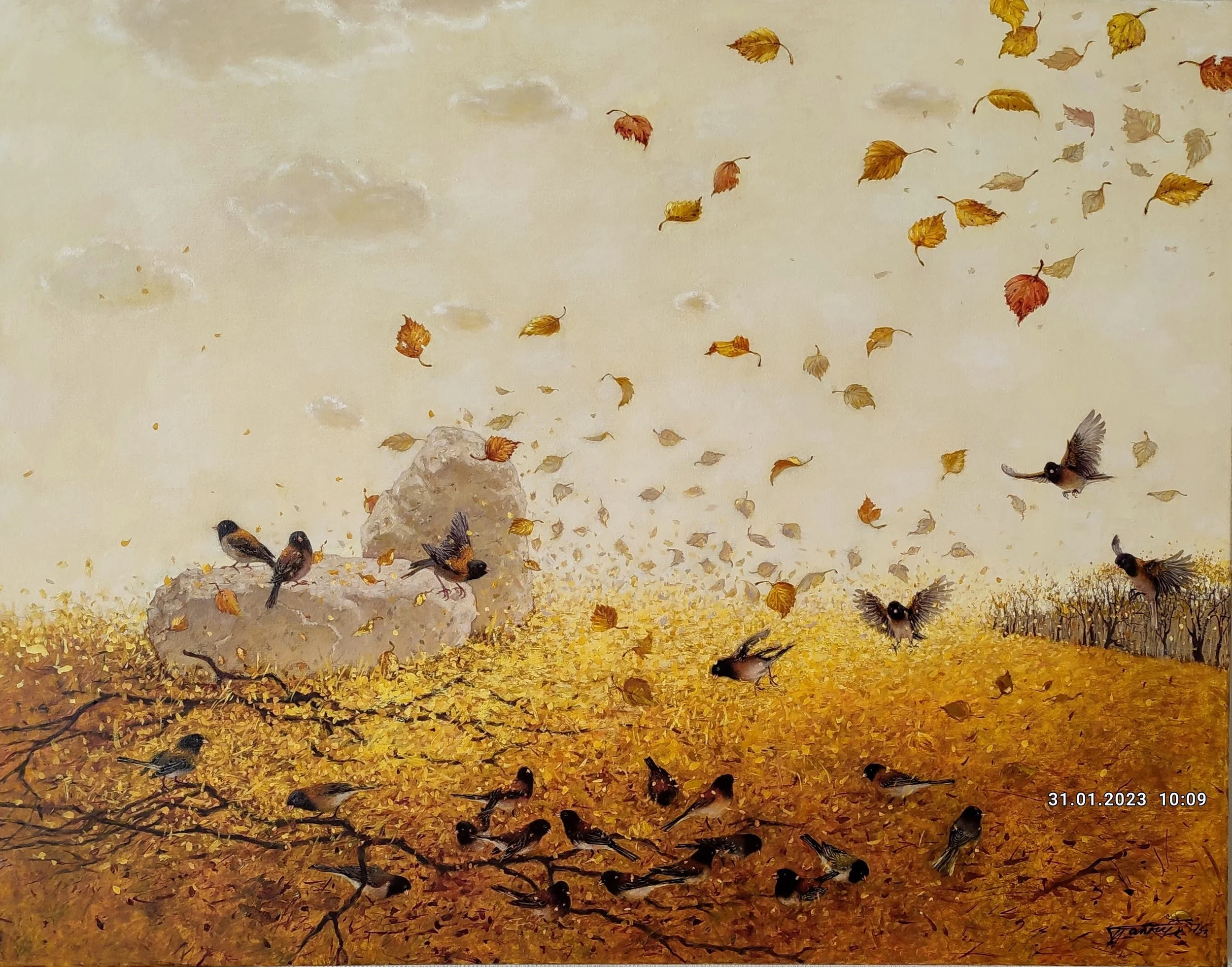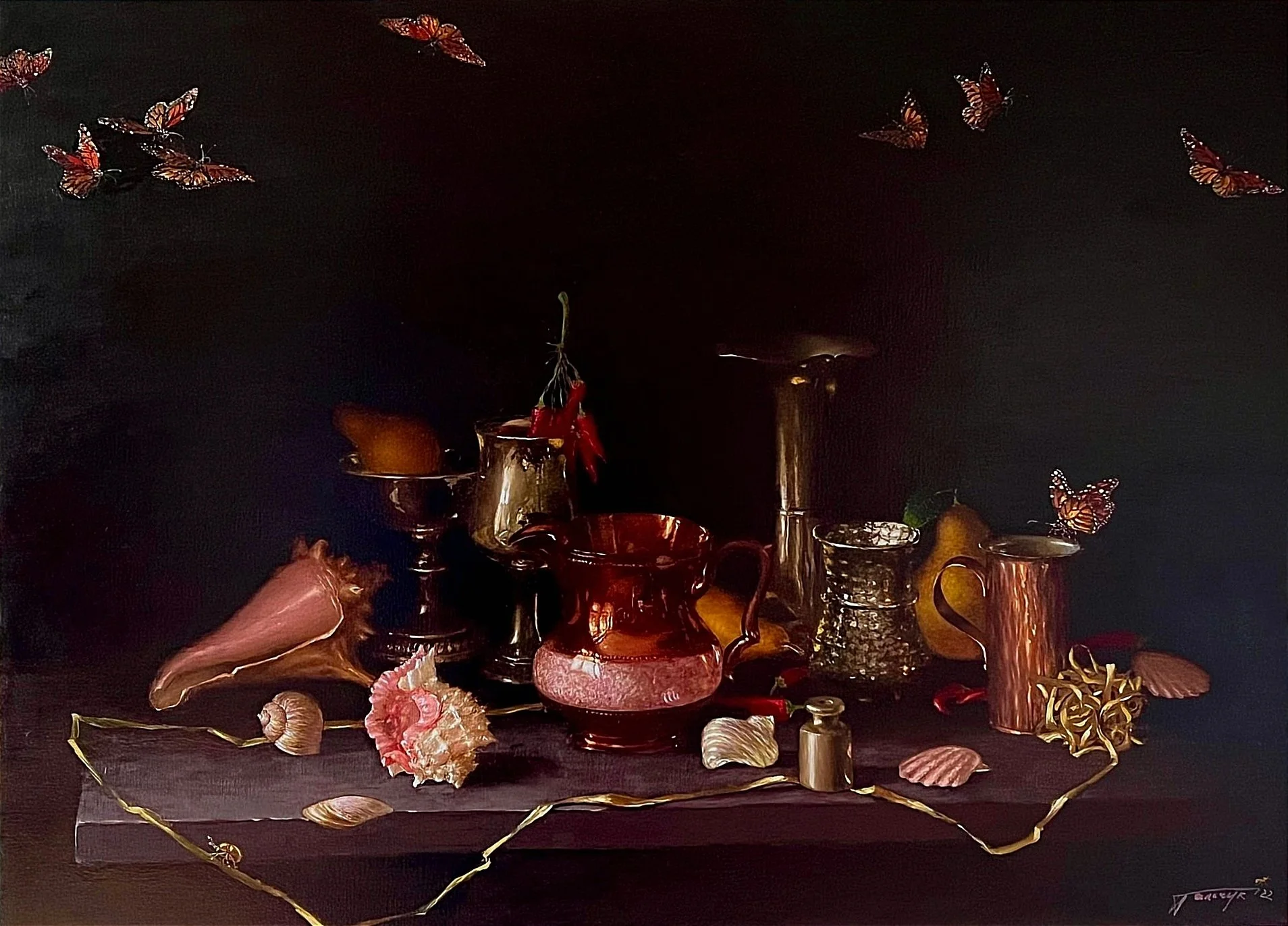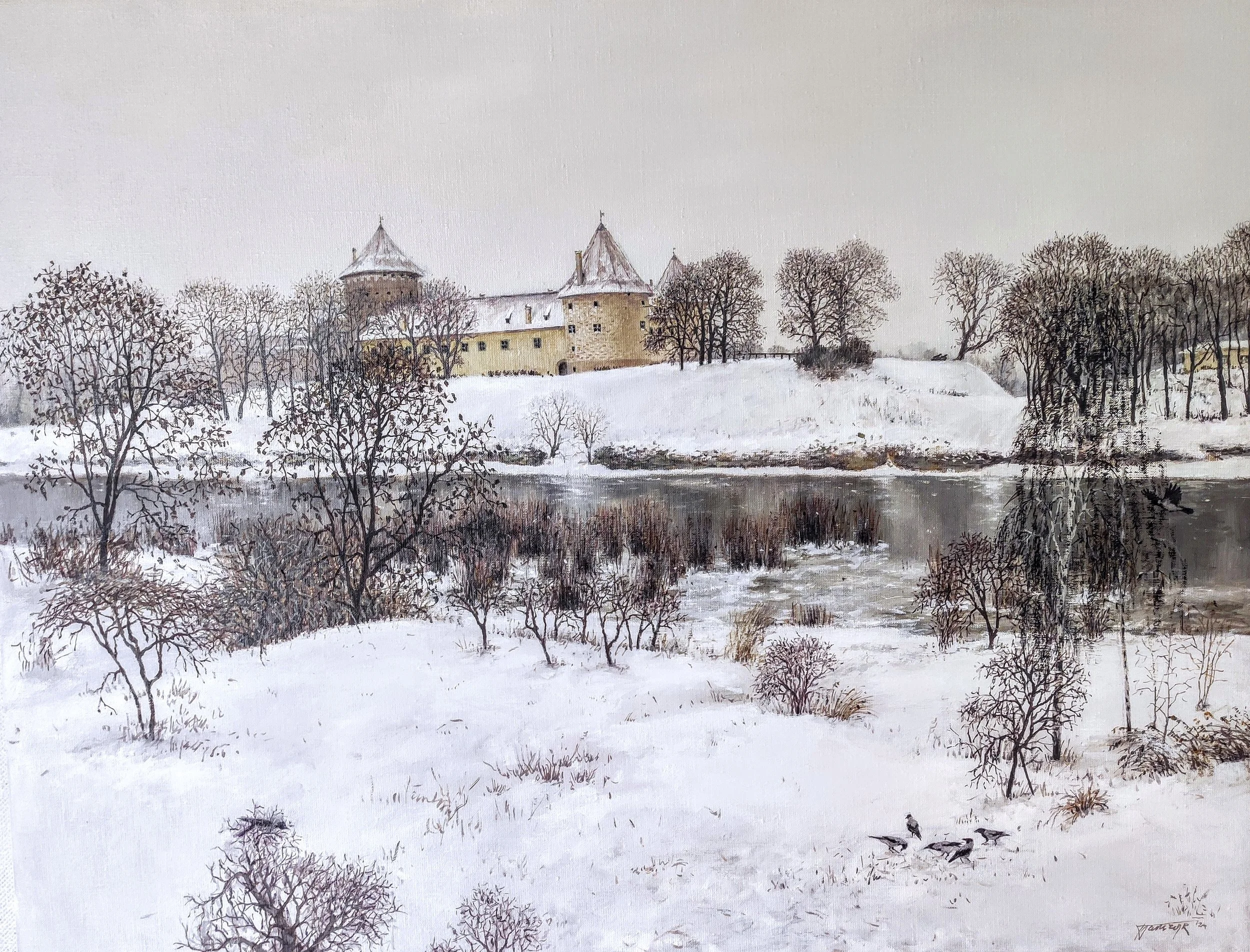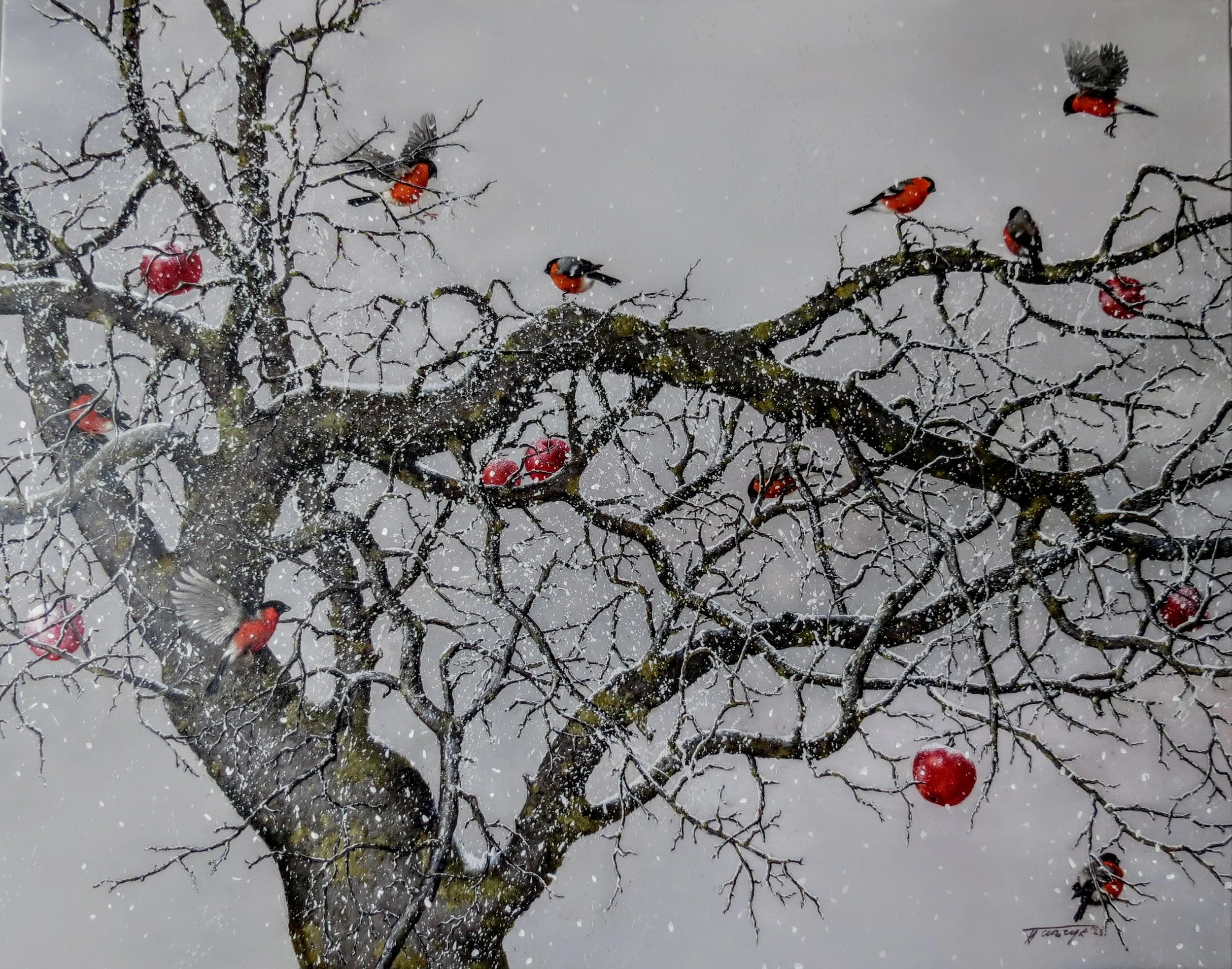Interview with Tatyana Palcuka-Rikane
The European – Baltic Artist Tatyana Palchuk
Tatyana Palchuk was born 1954.and has been living all her life in Riga, in a small area between the Art Academy and Elizabeth Street. Already during the kindergarten teachers predicted the little drawer an artist's destiny. Although, nobody was connected to arts in the family, she was constantly drawing in sand with a stick in hands. Tatyana lost her relatives in soviets Stalins represions ( She have Ukrainian Dona’s Kozaks , Russian ,Hebrew roots) , and father at an early age and has been growing independently as other afterwar 50ies - 60ies kids, and she was the eternal engine and captain for the yard kids. Tatyana enrolled Rozentals Art School by herself even not informing her mum. The artist tells that becoming an artist was not as easy for her and she had drawn on to the level of the more talented school and academy members, in her opinion, only by thorough and accurate work.
Her teachers are indisputable stars of Latvia and Europe Art - Imants Vecozols, Pēteris Postažs, Boriss Bērziņš, Edgars Iltners and academic Eduards Kalniņš. She has been among the few who have done the Masters course with the Academic of USSR Academie of Arts Eduards Kalniņš. Tatyana is proud to have had the honour and uncommon luck to visit and grow artistically at the academic's home, studio , and also meet Masters visits at her small studio of only 12m2 in Elizabeth Street apartment. The experience and knowhow given by these art grands has been invaluable and it has helped Tatyana to grow the one and brilliant art figure, which she has become.
Tatyana living quite a secluded self-centered life of an artist. Therefore she can't be spotted in any parties, exhibitions and other events so typical in the world of arts. Tatyana doesn't attend contemporary art exhibitions and she finds her inspiration going to Europe culture centers rejoicing in Renaissance, Hollandaise, Italian and other world treasure artworks at famous galleries and museums. One of her favourite art museums is Gemäldegalerie in Berlin, which she tends to visit so every year. Tatyana's motto is that anything new hasn't been invented but it has already existed,and a Human is only a small part of macrocosm breathing harmoniously around us with microcosm inside itself, which is possibly as infinite. She is to no extent affected by the modern trends and loud attempts to draw attention to onself. The main characteristics of her works are positivism, humanism and harmony with united world. They have been drawn in an excellent painting technique and mixing modern and ancient - a manner characteristic only for this artist. No doubt it is psychologically a quite difficult road, always to be a bit of a stranger among peers. But there are a great many Tatyana's art admirers scattered all around the world.
Her works are in collections in many world countries, like wise in repositories of the Russian Art Union and Ministry of Culture of the Russian Federation. During the peak years of creativity Tatyana had an excellent success at international competitions and art markets ( last time, sells in Top 15, Ravenel Auction House and Hessinks ). Last years significant exhibitions was participation at international painting exhibitions in New York, Rome, Palermo, Antwerpen, Spain, Denmark, Deutshland, Taiwan, Czech and other world art centers.
My motto as an artist
T.Palchuk Artist Statement
Deep and complete knowledge of my profession are proven by long years during which I was learning and improving myself as a professional.
My creative work is first of all characterized by many exhibitions, publications and positive feedback from students, colleagues and art critics.
The basis of everything still remains academic professionalism. Even it is not a leading value in the arts currently – good master of his handcraft should combine talent and professionalism. It is definitely an advantage and provides additional quality to the work results.
My creative work is too long and varied to be described in one page.
T.P
I am confident that:
1. For representative of any profession, including creative and art ones, the first thing you need to do is acquire the skills of your handicraft.
2. If a designer or architect using his main tool - pencil - is not capable to draw his idea quick and simply to his customer – his is not a professional.
3. If an artist is not capable to sketch ideas and versions of his painting – he is again not a professional.
4. That is why I am sure, that the main thing I can teach to my student is to become a professional of his handicraft, having a will and contribution of what he does.
My conformity to the position qualifications is described in all attached materials.Geniuses and evaluation of student works should stay to the critics and prerogative of history.
T.Palchuk
Your artistic journey began under the Soviet regime and has spanned into the contemporary period. How has the socio-political evolution of Latvia influenced the thematic and stylistic shifts in your artwork over the decades?
Yes, the socio-political changes in Latvia brought a new breath and the freedom lost during the occupation of the Soviet (Russian) empire. It became easier in a symbolic sense to breathe and of course to work. Although I, in Soviet times, stubbornly painted what I wanted and how I wanted. You can see this by looking at my early paintings. Of course, I understood that it did not meet the trends and requirements of the time to build the career of an artist recognized by the Soviet authorities. And yet, artistic and cultural life in Latvia was relatively freer and less limited by the conditions of communist art than in the USSR as a whole. I was lucky to be born and study in Latvia, which conditionally, together with Lithuania and Estonia, was and remained the "little west" of the USSR empire. And at wonderful Art Meters who have studied Western European art schools and traditions. The change of political power brought me complete creative freedom. And there was no longer political - ideological censorship in the process of selling paintings. A lot of opportunities opened up to work freely and creatively, and to realize my art for those who like it and appreciate it.
You have described living a somewhat secluded life, often distancing yourself from the contemporary art scene. How has this isolation influenced your creative process, and do you believe it has been more beneficial or detrimental to your artistic expression
I also now live quite privately, lonesome artist's life. Of course, this is neither bad nor good. For me, it is simply comfortable, calm and cozy. This is my world, the life nest of me and my husband, my art agent and promoter Peter Rikan. My workshop is in our private house, where we have created a decorative garden with lots of wild plants, a small pond and shrub plantings. Therefore, the active life of wild birds and other small creatures goes on outside the window all year round, and we are inside it all. I draw, paint and music plays in the background. Peter organizes my Solo Show once every 4-5 years. Participating in the noisy processes of modern art and in the constant struggle for a place under the sun takes a lot of time and mental energy. It's not my way. This is what my Peter does. It is a difficult and important job for which I am absolutely not suitable and thank God that we have met each other. Because promoting and selling art is an almost impossible mission, it requires a special, different kind of talent. And it is good that there are people in the world who do this, starting with publications, competitions, contacts, exhibitions and ending with art fairs. Often, the artist with his art is only a small, not the most important, part of the whole big process.
With your rich and diverse heritage—Latvian, Ukrainian, Russian, and Hebrew—how do each of these cultures manifest in your art, and how do you balance these influences in creating a personal artistic identity?
I never thought about it. I guess it never mattered to me. Because as an artist, I grew up and matured under the influence of the Latvian school of fine arts and cultural identity. But this school has been formed as a part of the art heritage of Western Europe since the self-awareness of the Latvian Nation. My interest in the ancient Russian Icon is closely related to the Italian Proto-Renaissance. Both are based on Byzantine Christian art. I love the Northern Renaissance, International Gothic, Illuminations, which do not obey any ethnic explanation at all. I can summarize that my artistic identity is Western European art from Ancient Greece to the present day.
You have a deep philosophical connection to the macrocosm and microcosm concepts in your works. Can you elaborate on how these philosophical stances challenge or enrich your creative process, especially when translating such abstract concepts into visual art?
I think...it's my perception of the world, my attitude towards everything around and within us. My place in all this. Who am I.....how infinitely harmoniously arranged everything living and non-living in nature is, how everything is interconnected. On the one hand, You are the center of everything, but on the other hand, not even a small dust , a grain of sand, not even a gust of wind that does not depend on you, but you on her even very much.... The universe is unfathomably infinite and who is a person in it??? There is no deliberate evil and no good in nature. She just is! And I enjoy it and try to share this wonderful feeling with my viewers. Well, something like that.....And whether I succeed - let the viewer judge.
In an era where contemporary art often embraces rapid changes and trends, you've maintained a classical approach to your art. How do you navigate the pressures of the modern art market while staying true to your artistic convictions?
Contemporary art market.......What is it? How does it form, what shapes it, what influences it? Lots of questions. It's better for me to abstract from it all and do what I love and, it seems, I know how to do well, regardless of todays quicly trends that come and go and time will definitely sift the wheat from the chaff. Realistic art is what is close and interesting to me. In this art, nothing needs to be "deciphered", there is no need to think of something that is not there,and it needs to be explained as complex as possible. There is a painting and there is a viewer. And they are on the same breath, and they have met. Here, both can be done without endlessly long explanations, which you have to imagine and how the Art Guru felt at that moment. Realistic art has always been and will be interesting to the viewer. Of course, if we are talking about high-level art of this direction.
Having been mentored by some of the greatest names in Latvian art, how do you perceive your role as a mentor now? What core principles do you aim to pass on to your students, and how do you measure your success in this regard?
I'm 70 this year. And I don't teach anymore , only sometimes consulting. But I have maintained friendly and warm relations with my former students and pupils. They tell me that I have taught and gave them a lot. Both in the profession and as an advisor in life. I believe that the first thing that needs to be taught to a budding artist is the skills of his job. First, drawing. Then the study of colors, good perspectives, composition and materiality skills. What my teachers passed on to me, I passed on to my students. And it is very important to help art students find their individuality, their own, preferably highly professional handwriting. And then further ....to each his own "free swimming"
You have expressed a profound love for certain colors and techniques, such as your use of pearly paints and oil layering. Could you discuss how you arrived at these preferences and how they help convey the emotional depth you seek in your works?
Yes, I obviously have colors that are particularly close to me. I really love all shades of gray, there are so many of them. I love yellow, from ocher to gold. Of course, the choice of color range in the work initially depends on the idea. For example, I have the Still Life series of paintings "Rainbow", where there are all the basic colors of the rainbow, each painting has its own. I am a lover of the Great Giotto. The blue color in his frescoes is simply enchanting. Together with golden ocher - it's fantastic. I once saw a delightful little blue mug with a gold handle and rim at Fla Mart. I bought it and painted a Still Life with it. The cup stands on a color palette with color tubes and I wrote Giotto on it in small letters. This small painting is a tribute and my admiration for my beloved Great Master. In your question, you perfectly say: "emotional depth". I think this is the main thing in visual art. Good art always appeals to emotions. In my case, absolutely positive emotions.
Over the years, you have received significant recognition, including international awards. How do these accolades affect your approach to new projects, if at all? Do they validate your artistic path or add pressure to conform to certain expectations?
Recognition, praise, international awards, of course it's very pleasant, but it doesn't change my attitude or thoughts when starting a new project. But it helps me to feel more confident in my abilities and to feel more confident about my level of art. It's normal to feel self-doubt, but you can't be insecure all the time. When you reach a certain maturity, it is good to stop, look at yourself, your work from the outside and say to yourself: "You are a good girl and you have succeeded!". This is definitely what an artist needs. On the other hand, recognition from other people, especially from professionals of one's guild - well, it gives wings and gives new strength.
One can only be thankful for that and try to continue working without losing the achieved level.
Music plays a vital role in your creative process. Can you discuss a specific piece or project where music directly influenced the creation of an artwork? How do you translate auditory sensations into visual expressions?
Of all the arts, I put music above all. Music cannot be touched, it cannot be seen or tasted, but its influence on a person is enormous. It makes us cry and rejoice. And only 7 notes, but what do that do with us. How it can be created, it is a real gift of the Creator to people be able to do it and for us to feel it. I have had and, I hope, there will be more paintings on the theme of music. For example, the Polyptych "Anthem to Creativity". In it, young modern people play musical instruments and sing. It is interesting that the idea of this cycle came to me in a dream after a day in Assisi. There were many young people in the square near the church of San Francesco in some kind of spiritual celebration. They sang, played some Christian hymns and were spiritual and happy doing it. It was so wonderful and uplifting. It moved me to tears. That's how an idea for something beautiful and positive arises. And when I paint, music always plays. Both symphonic and classical jazz and good pop.
Looking forward, how do you see your artistic style evolving, and are there new themes or techniques you are eager to explore? What upcoming projects or exhibitions are you most excited about, and why?
There are new ideas, topics, and a lot of them have been written down, but I think there won't be enough time to realize everything. I never rush the creative process. The idea must first mature in the head and then in sketches and drafts. You have to find the best compositional solution and come up with a solution in colors. In my understanding, this is already a whole process of creation, and it is very interesting when there is still a lot to be done before the birth of the painting on the canvas. I usually make a drawing as a separate graphic work, where everything is already solved. It remains only to transfer to the canvas and paint.
Throughout December until January 2025, my anniversary year Solo Show will be held in Valmiera, Latvia, dedicated to my 70th birthday. There will also be a presentation of a book about me that was published in September. The author of the book is my Art Agent and husband Peter Rikans. It is an anniversary gift from him and my admirers, for which I am very grateful. The introduction was written by Ingrida Burane, the most recognized art critic and cultural writer in Latvia. I am happy and grateful to everyone who loves me and my art.
Thank you, too, for thoughtful and very interesting questions.
With love - Tatyana Pachuk. 2024.
You Tube Channel about T.Palchuk
https://www.youtube.com/@peterisrikans7238
Artists webpage – www.tpalchuk.eu
Agent's email – perikans1951@gmail.com



